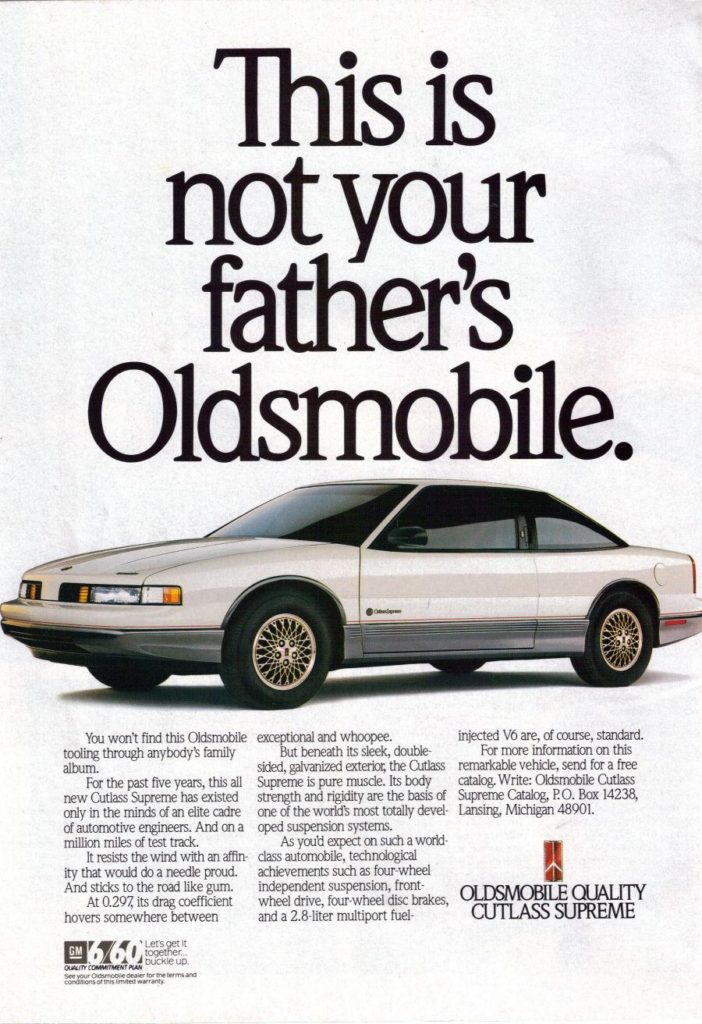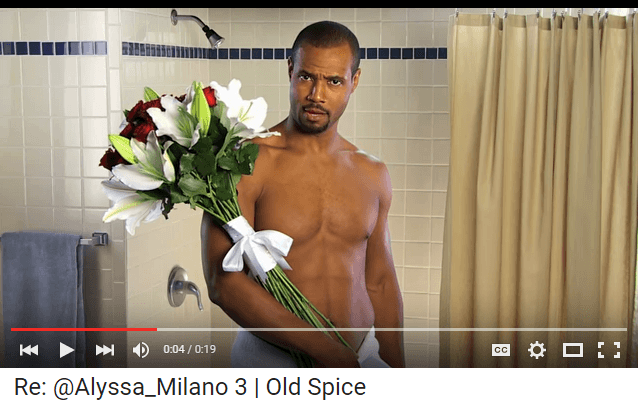Whether you love her or hate her, everybody has an opinion on the music of Lizzy Grant. A true pop star and style icon, she’s the most-streamed female artist on Spotify, not to mention her Grammy, multiple Billboard Top-10 hit singles, and infamous “Saturday Night Live” performance.
What’s that? You’ve never heard of Lizzy Grant?
Oh, that’s right, I forgot to mention that in 2011, Lizzy Grant rebranded herself as Lana Del Rey. Minor detail.
Rebranding can make or break a career – or a company. Just ask Oldsmobile. Actually, you can’t. After a failed attempt to rebrand in the early ‘90s with a newfangled logo and tagline, “This is not your father’s Oldsmobile,” the company went undercarriage‐up by 2004.
 Turned out that this was your father’s Oldsmobile, after all. If it wasn’t, then it must have been your grandfather’s Oldsmobile, because it clearly wasn’t yours. Perhaps having the word “old” right there in the title didn’t help, nor did the still cartoonishly elongated frame, which fit right in with the manufacturer’s public perception as building a car for senior citizens.
Turned out that this was your father’s Oldsmobile, after all. If it wasn’t, then it must have been your grandfather’s Oldsmobile, because it clearly wasn’t yours. Perhaps having the word “old” right there in the title didn’t help, nor did the still cartoonishly elongated frame, which fit right in with the manufacturer’s public perception as building a car for senior citizens.
Then again, Old Spice triumphed gloriously over the very same word. A product often similarly associated with generations past, Old Spice enlisted the expert rebranding capabilities of Wieden+Kennedy, who dreamt up a self-aware and hilarious new concept revolving around hunky actors Isaiah Mustapha and Terry Crews. This is the man your man could smell like.
More than 40 million YouTube views later, and with a 27 percent increase in sales year-over‐year in the first six months after the new line of commercials’ debut, Old Spice’s hipper, younger rebranding was accomplished. While those sales might have begun to dip again in the past year, the company still serves as an inspirational model of what a rebrand can accomplish when paired with an honest and forward-thinking reappraisal of a product’s potential.
You can’t teach an Oldsmobile new tricks, but you can teach them to an Old Spice. If you’re considering a similar reinvention of your own brand, this comparison can offer plenty of fertile ground from which to attempt to grow sales, awareness, and overall public perception.
Old Spice succeeded not because it was more aware of its public perception than Oldsmobile, but because it better estimated the potential of its base for growth and redefinition. Perhaps Oldsmobile would have fared better had it focused on the demographic which had served it well for so many years. Could it be that there’s more room for humor in the marketing of a $3 stick of deodorant than there is in the marketing of a $30,000 automobile?
In order to shake off the mantle of the “old,” it’s also crucial to walk the walk. Whereas Oldsmobile relied heavily on traditional forms of advertising to get its new branding across, Old Spice created content that would have a life of its own.
Commercials rich with visual gags produced ready-made YouTube content, and the company took it a step further by filming 180 custom fan response videos that it uploaded to its channel.
A custom video in response to a tweet from Alyssa Milano
Part of this was the difference a decade (or two) made, and the onset of social media seemed to provide more opportunities than ever for brands such as Old Spice to show off their newness. Multi‐platform campaigns turned its market segment into “fans” and “followers” by making them feel heard and directly spoken to.
Sometimes, however, the more things change, the more they stay the same. Take Columbia Sportswear, for example, and its recent decision to re-rebrand. In the ‘90s, the company experienced rapid growth after debuting parkas enhanced with Gore-Tex, and a droll ad campaign starring company founder Gert Boyle. The “One Tough Mother” ads showed Boyle running her son Tim through a car wash and hanging with a biker gang, expertly playing off her seasoned, no-‐nonsense persona to show the durable, timeless quality of Columbia’s products.
Gert Boyle and a few friends.
After ditching the campaign in the early aughts, Columbia is reviving it with a new series of “Tested Tough” spots where Boyle puts her employees through the ringer to show off the quality of Columbia gear. For the past decade, an advertising campaign focused solely on Columbia’s clothes and technology had yielded diminishing results, and in a recent Adweek article, Columbia chief marketing officer Stuart Redsun said that “ … no one really knew what the brand stood for.”
Re-enter Boyle, along with a brand re‐invigorated not only by a new tagline, but also a new hash tag, #TestedTough. Combining the lessons learned from Oldsmobile and Old Spice, Columbia has created a campaign at once aware of its products’ strengths and key demographic, but also making full use of all available marketing platforms, traditional and social, to tell a story both old and new.



In the Adweek article, industry consultant and marketing professor Michael Solomon explains that “older women are ‘in’” right now, citing Joan Didion and Iris Apfel’s recent spots for Celine and Kate Spade. He also credits nostalgia for the 1990s as a key factor in Columbia’s decision to revive old branding. That’s ironic when you consider that in the 1990s, Oldsmobile failed to accomplish its own rebranding due to a changing marketplace and lack of awareness of its company’s key selling points.
Ultimately, rebranding is a risk.  When done blindly, it can backfire spectacularly, or at the very least reinforce feelings of apathy toward a fading brand. When a company is willing to do the research to understand its core consumer, and create a marketing strategy that continues to engage that person while also making use of the newest social channels and other digital avenues to drive interest, traffic, and sharing, rebranding can give a company a new lease on life. To help you get started, Act-On has created an eBook, 5 Ways to Integrate Social Media Across Marketing Channels, to help you navigate how to integrate social media into your marketing strategy.
When done blindly, it can backfire spectacularly, or at the very least reinforce feelings of apathy toward a fading brand. When a company is willing to do the research to understand its core consumer, and create a marketing strategy that continues to engage that person while also making use of the newest social channels and other digital avenues to drive interest, traffic, and sharing, rebranding can give a company a new lease on life. To help you get started, Act-On has created an eBook, 5 Ways to Integrate Social Media Across Marketing Channels, to help you navigate how to integrate social media into your marketing strategy.
If you find your company at a crossroads, and suspect that it’s time to take a fork in the road, you may very well be right. The key to deciding which fork to take is understanding your surroundings – both in terms of your market segment and the overall media landscape – and taking the time to build a vehicle capable of carrying you down that road to success. Otherwise, you may leave the familiar behind, only to find yourself in strange surroundings with no sense of how to get back where you started.
(Are you convinced that it’s time to rebrand, despite the risks? Don’t go into these woods alone. Get objective advice from the smartest agency or brand specialist you have access to … and listen to them.)




